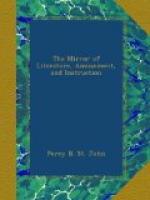and the Scots and Picts; the dome-shaped hill of Tinto,
in Lanarkshire, 60 miles from Stirling, and 2,336 feet
in height; Arthur’s Hill, a circular mound of
earth, surrounded by seats of turf in the royal gardens,
sometimes called the king’s knot, where the court
held fetes, and where James used to amuse himself with
the pastime called the Knights of the Round Table;
Ben Lomond, 3,240 feet above the lake, which is 32
feet above the level of the sea; Ben Venue, and Ben
Ledy, or the hill of God, in Perthshire, 3,009 feet
in height, so called from the inhabitants of the surrounding
villages, in former times, meeting on its summit at
the summer solstice, three days and nights for the
purpose of devotion. These three mountains, with
their vicinities are enshrined in Sir Walter Scott’s
Lady of the Lake; and the village of Balquidder,
at the foot of Ben Ledy, is the burial place of Rob
Roy. We have just described the circle: over
the garden wall of the Castle, at a considerable distance,
is the well-wooded estate and mansion of Craig Forth,
said to have once belonged to a blacksmith of Stirling:
this man having placed the iron bars (which still remain
to the windows of the palace), and done other work
for James VI. when that monarch came to the throne
of England, made a demand of one thousand pounds Scots,—but
by some error, the accounts being paid in Stirling
money, he with it purchased the estate and built the
house of Craig Forth. Next, to the right is Blair
Drummond, formerly the residence of the accomplished
Lord Kaimes; and beyond are the celebrated ruins of
Donne Castle; not the least interesting incident of
its annals was the imprisonment there in 1745, of
John Home, (the author of Douglas,) who has left a
narrative of his clambering escape over the high walls.
It is time to speak of the Panorama as a work of art;
for hitherto we have rather considered its intellectual
interest. The Castle and Palace we take to be
finely painted, with admirable picturesque effect:
the huge gateway, flanked with two towers, the battlemented
walls, and battery, are in fine bold relief, as is
the clinging vegetation about the building; nor must
we omit the grotesque figures or corbelled pedestals,
and the identical window bars, the work of the wily
Scot of Craig Forth; the latter especially, are clever.
A portion of the esplanade otherwise devoid of interest,
is peopled with a meeting of the Highland Society
celebrating the feats of the ancient Caledonians, the
object of the Society being to preserve their language,
costume, music, gymnastic sports, and martial games.
This introduction happily fills up what would otherwise
have been the only void in the scene, so thickly is
it studed and storied with objects and recollections.
Altogether, we have rarely seen a topographical panorama
of such diversified character: it has reminiscences
of history and poetry to lead us through the retrospect
of chivalrous ages, princely contests for crowns that




